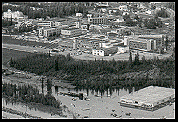Public Service: An Added Dimension, Fairbanks Flood 1967 - Part 1
This story about the university's important role in Fairbanks' 1967 flood appeared in July-August 1967 issue of Now in the North.

The story began Monday, August 14, 1967 when it became apparent to Alfred H. (Al)
George, university assistant comptroller for research, that a serious flooding problem
might materialize in Fairbanks and that the university might be called upon to provide
emergency housing for flood victims.
As civil defense coordinator for the university, George would be responsible for making
arrangements. After consulting with David Mangusso, head of student housing, he informed
civil defense authorities in Fairbanks that the university had 300 beds available
for refugees.
These beds represented the difference between campus dormitory capacity and the number
of students and other persons attending summer programs who were living on campus
at the time.
That evening, the Chena began to flow unchecked through Fairbanks and surrounding
areas and the first flood refugees began to stream toward campus. As the river continued
to rise and it became apparent that thousands of residents would have to leave their
homes, Dr. William R. Wood, president of the university announced that the university would welcome all persons seeking shelter.
His announcement was broadcast over KUAC, the university's student-operated FM station
and over Fairbanks radio outlets, and the trickle of refugees toward campus suddenly
became a torrent.

They came at first on foot, by bicycle, by pickup truck, car and camper - by about any means that had wheels. Many arrived only with the clothes they wore.
As roads became impassable because of the rising waters, hundreds of refugees also
began arriving by canoe and flat bottom riverboats. At one point, the foot of College
Hill near University Avenue and College Road resembled a marina.
In the air, giant H-21 helicopters from Eielson Air Force Base and an armada of other
civilian and military "choppers" ferried refugees from rooftops to a helipad that
had been set up on a parking lot south of the university's Bunnell Building. Col.
Billy Clemmons, commander of the Air Force Station at Murphy Dome, directed the helipad
operation.

After they arrived on campus, evacuees were taken to the campus housing office in Hess Hall and directed to sleeping quarters. When space in the university's eight dormitories ran out, refugees were sent to classrooms, recreation rooms, laboratories, lounges and ultimately, to any building where a blanket or a sleeping bag could be put down.

Public Service: An Added Dimension, Fairbanks Flood 1967
